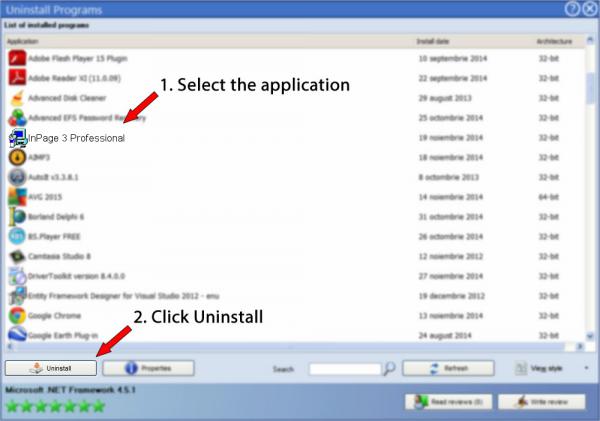Aslam O Alykum,
Meray Payaray IT Expert Bhaio Mainay Inpage 3 Professional Download Kia Hai 2 Mukhtalif Links SE ... Or 1 Ajeeb Masla Aa Raha hai Usmai .. Jab B Mai Us Mai (inp) File Bnaa ker Save kerta Hon Or Phir Dobara Open krta HOn TO Inpage Crash Ho Jata Hai .. or File Khulti Nai Program Band ho Jata hai .!! 1 TO Ye Masla Hai Doosray Link SE Download Kia To Usmay Inpage Chaalany Per Ye Error ata hai .. E0209 -- Sentinel Key not found. Or Inpage Chalta He Nahi ..!!
Ye Masla Koi Mera Bhai Hal Ker Day Yar Bohat Tension Mai HOn .!! Mujay Inpage 3 He Chaye Usmay 1 Option Use kerna Chahata HOn .. K-auto k-always Wali Or Unicode Fonts Sirf 3 Version He support kerta Hai ye to apkO maloom he hOga .!! Please Zara Jaldi Rply KEr Diya Jae To Haaksar Duao mai Yad keray Ga .!!
Allah Apka Bhala Keray .!!
Shukriya .!!
E0209 Sentinel key not found at first but i think it was cuz of the anti virus progam. Did it again, now working. Love man thnx Spickz at 2017-04-05 14:27 CET. If you are using the Rainbow Sentinel-C hardware key provided by Artwork on Windows NT 4.0 you will need to install the 5.17 key driver in order for the key to work. Otherwise you will get the dreaded 'KEY NOT FOUND' running in demo mode. Procedure Log on as Administrator. The key driver cannot be installed by users without administrator. TechTube is a series of tutorials offering the latest support and education on SafeNet Sentinel Products. In this session you will learn how to update a Sent.

Software Solutions
Engineering Services
Learn More
Company Information
Hardware Key Frequently Asked Questions
Q-1. What is the difference between a standalone and a network hardware key?

A-1. A so called 'standalone key' refers to a USB key with 'Sentinel SuperPro' printed/embossed on it. This key works with a single-user non-network version of CAEPIPE software (in other words, this key runs CAEPIPE on one PC locally to which the key is connected; CAEPIPE cannot be accessed from any other PC on the same network). A 'network key' refers to a USB key with 'SuperProNet' printed on it. This key works with a single or multi-user network version of CAEPIPE software (in other words, this key allows CAEPIPE to be executed from any PC on a local network and beyond using WAN capabilities (see q. 12 for more on this topic)).
We do not use the LPT keys anymore. If you have an old one, contact us for a free tradeup if your CAEPIPE version supports it.
Q-2. SuperProNet (SPN) hardware key: I received an SPN key. Even after I loaded the drivers, CAEPIPE software and connected the key, CAEPIPE does not start. It reports a 'Status=74' error. What is wrong?
A-2. On the computer where you are starting CAEPIPE, make sure that you define an environment variable (NSP_HOST = IP address of the computer where the key is connected) and that the drivers are loaded. Open the 'System Properties' window (press the Windows key+Pause/Break key) > click on Environment Variables under the Advanced tab. Click on New. Type NSP_HOST for Variable name, and the IP address (or computer name) of the computer where the key is connected for Variable value. If you are unsure, please contact your system administrator to get this done.
Also see Questions 11 and 12 below for related information on SuperProNet Keys.
Q-3. Do I need the hardware key drivers on Windows 9x?
A-3. The drivers are required on WinNT/Win2000/later machines and are highly recommended for Windows95/98. If you do not have them, you can download the self-extracting file from Customer Support > Hardware Key Protected page.
Q-4. The message 'Hardware key not found' occurs repeatedly. Is there a utility that can search for the key or otherwise verify that the key is ok?

A-4. Yes, we do have such a utility (for standalone and network keys). It is called Sentinel Advanced Medic. You can download it from the next link. This utility will require the system driver (go to this page for the latest driver software) to be installed on the computer you are checking. So, if you have not installed the driver, please go to the previous link, download and install the driver/server software. This should fix the issue. If not, download the Sentinel Advanced Medic (556KB) (zip) tool for further testing. Once you download, install to a folder (on the desktop), navigate to it, and run the 'SAMxxx.EXE' application. If you have a network version of CAEPIPE (see Q1 above, then specify the server's IP address and click on 'Network Test'). Anything reported missing will need to be taken care of before CAEPIPE can function correctly.
Q-5. How to test if the hardware key is okay or if the USB port (on the PC) is ok?
A-5. To test the port, please verify proper operation of the port by connecting and operating a USB device (such as a printer). To test the key, first ensure that the key's green/red LED is on when connected. If not, try another good USB port. If ok and you still have a problem, then you may have to connect the key and install the driver and CAEPIPE on another PC. Execute CAEPIPE on it. If you get the same error, (something like 'Protection error, key not found'), then that key *may* be defective. Alternately, try the Hardware key finder utility available on our website (see previous question). If all else fails, contact Technical Support.
Q-6. It takes a long time for CAEPIPE to find the network hardware key? Is there an alternative?
A-6. Yes. Please see solution to Q.2.
Q-7. Do I have to load CAEPIPE Network version program files on a Windows server (like a Windows 2003 server) machine?
A-7. No. CAEPIPE operates in a Windows network. Any computer on the network can be designated as a CAEPIPE server (a _CAEPIPE server_ is one which has a CAEPIPE hardware key with the requisite driver loaded). The hardware key should be connected to a USB port.
The server for the hardware key supports NetBIOS, NWLink (Microsoft's IPX/SPX), NetBEUI and TCP/IP. Additionally, CAEPIPE server can also be accessed remotely using WAN. You will need to contact your system administrator for setting this up.
Q-8. Can I connect more than one Safenet key so that I can run multiple applications?
A-8. Apparently, a software protection scheme from Safenet is the only one that conflicts with a hardware key. Other than that, multiple hardware keys can be connected and their apps run.
Should you run into a problem, contact us so we can contact Safenet for a resolution. The temporary solution is, of course, to connect only the CAEPIPE key.
Q-9. Do you know how much traffic will be generated (25KB, 35KB etc.), by using your program tie-in with our application? We are worried that CAEPIPE's lookup mechanism will add to the noise already present on our networks.
Sentinel Ldk Protection System H0007
A-9. The traffic depends on how often the client queries the server for the presence of the key and the number of servers as well. The lower the frequency of the queries and the number of the servers, the less the traffic generated. The majority of the software overhead would be in the server discovery process in which multiple tries (default 9) for each server (maximum of 5 servers allowable) is being polled. In each try, the traffic size is ~ 100 bytes. To reduce the traffic to its minimum, we would suggest lowering the server count and the retries.
Q-10. SuperProNet Key: We hear from several of our clients about the license manager software not updating the # of available licenses when an application crashes or when a remote connection is dropped. Is there a workaround for this issue short of rebooting the server PC?
A-10. QUICK WAY: Although the software servers will eventually time out the user, you may restart the two services (Sentinel Keys server and Sentinel Protection server) to reset the # of available licenses.
HOW TO KILL LICENSES: To remove the clients that are no longer being used, see below.
Several users have asked us to provide the ability to track and manage CAEPIPE licenses on a network. Thus far, there were utilities to track usage but not manage them.
Not anymore! Starting with the latest hardware key driver/license manager update we recently released (version 7.4.2), you can monitor and kill CAEPIPE licenses. The following procedure is best executed by your IT person or someone conversant with Windows IT issues.
Ensure that Sentinel Protection Installer v7.4.2 (or higher) is installed and working on your system. If you have not installed it yet, you can get it here.
Download and print the PDF document, ReadMe.pdf. This document contains detailed instructions on how to track and manage starting from around page 5.
Following the instructions clearly will show you how to terminate (locked) sessions. Note that the essential PwdGenUtility can be found in C:Program FilesCommon FilesSafeNet SentinelSentinel Protection ServerWinNT.
Q-11. CAEPIPE and the drivers are installed. Yet, CAEPIPE can't find the SuperProNet Key, and returns 'key not found'. What to do?
A-11. Please follow the steps below.

- Verify that the SuperProNet key is plugged in (and that the LED on the key is lit). Ensure that the port is ok.
- Verify that the two server applications are running as services (see Administrative Tools > Services, look for 'Sentinel Protection Server' and 'Sentinel Keys Server'). If not 'Start' the services, if they were already running, 'Restart' the services.
- Make sure you have defined the NSP_HOST environment variable. See answer to question 2.
- After you have verified the key is plugged and the servers are running, and you still are receiving 'key not found', the last step is to verify that you have installed the latest driver. Be sure to uninstall before installing again.
Q-12. Notes on SuperProNet key and WAN
E0209 Sentinel Windows 10
A-12. Use the Sentinel Advanced Medic tool to see whether you can see the machine with the key. Then, you should set the environment variable NSP_HOST equal to IP address of the machine that has the key. This variable should be set on every client that wants to access the software. Next, you must open any UDP packet communication among your routers. CAEPIPE clients and server communicate via UDP on port 6001.
E0226 Sentinel Key Not Found
In some cases if you have different subnets, you must configure the routers to open UDP port 6001 to let the UDP packet coming from the client, go across the network to the other subnet and find the key. If you don't open the UDP ports, or don't set the environment variable (NSP_HOST), there's a chance that when the client tries to find the key, this UDP packet gets lost. If no NSP_HOST is configured, then CAEPIPE's broadcast to the network via the UDP packet looking for the server might get lost, timing out the client with the 'error 3, key not found.' Setting the NSP_HOST to the IP address of the machine with the key avoids the broadcast with the packet, and finds the specific machine with the specified IP address.